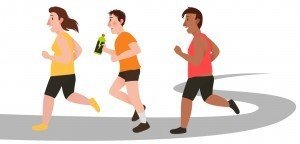Sport Drinks
 Over the past decade, sports drinks have moved out of the domain of serious athletes and into our kitchens. The sport drink industry was born when an assistant football coach and team physicians for the University of Florida Gators discovered two key factors that caused the football players to lose energy and stamina during practice: loss of fluids and electrolytes through sweat and not replenishing the large amount of carbohydrate they needed for energy.Athletes today continue to use sports drinks to provide energy, maintain hydration, and improve performance. At the same time, consumers reach for lower calorie, lower sugar sports drinks as tasty thirst-quenchers, even when those people are not physically active. Let’s take a closer look at sports drinks to see whether they’re good for simply quenching thirst.According to the American College of Sports Medicine (ACSM), the goal of fluid intake during exercise is to prevent excessive dehydration and excessive changes in electrolyte balance that can lead to heat injury and decreased athletic performance. What are electrolytes, you ask? Electrolytes are positively and negatively charged ions that play an important role in maintaining optimum fluid balance within our body. Sports drinks contain the electrolytes (sodium, chloride, potassium, magnesium and calcium) that get lost when you sweat.Sports drinks also contain 6-8% carbohydrate. Maltodextrin, glucose, sucrose, and fructose — alone or in combination — are the carbohydrate sources in most sports drinks. They are digested quickly and maintain blood glucose levels to rapidly provide energy to exercising muscles as well as fuel the brain.Sodium in sports drinks stimulates thirst and enhances fluid retention. The flavoring and sodium content improves the taste of the beverage, which encourages consuming larger amounts.Sports drinks that contain electrolytes with fewer sugars and calories are gaining popularity among athletes and consumers. The flavored beverages may contain artificial sweeteners, and while the electrolytes can help promote fluid absorption, they do not provide energy necessary for endurance exercise lasting longer than one hour.So, what role should sport drinks play in your life? I recommend that you…
Over the past decade, sports drinks have moved out of the domain of serious athletes and into our kitchens. The sport drink industry was born when an assistant football coach and team physicians for the University of Florida Gators discovered two key factors that caused the football players to lose energy and stamina during practice: loss of fluids and electrolytes through sweat and not replenishing the large amount of carbohydrate they needed for energy.Athletes today continue to use sports drinks to provide energy, maintain hydration, and improve performance. At the same time, consumers reach for lower calorie, lower sugar sports drinks as tasty thirst-quenchers, even when those people are not physically active. Let’s take a closer look at sports drinks to see whether they’re good for simply quenching thirst.According to the American College of Sports Medicine (ACSM), the goal of fluid intake during exercise is to prevent excessive dehydration and excessive changes in electrolyte balance that can lead to heat injury and decreased athletic performance. What are electrolytes, you ask? Electrolytes are positively and negatively charged ions that play an important role in maintaining optimum fluid balance within our body. Sports drinks contain the electrolytes (sodium, chloride, potassium, magnesium and calcium) that get lost when you sweat.Sports drinks also contain 6-8% carbohydrate. Maltodextrin, glucose, sucrose, and fructose — alone or in combination — are the carbohydrate sources in most sports drinks. They are digested quickly and maintain blood glucose levels to rapidly provide energy to exercising muscles as well as fuel the brain.Sodium in sports drinks stimulates thirst and enhances fluid retention. The flavoring and sodium content improves the taste of the beverage, which encourages consuming larger amounts.Sports drinks that contain electrolytes with fewer sugars and calories are gaining popularity among athletes and consumers. The flavored beverages may contain artificial sweeteners, and while the electrolytes can help promote fluid absorption, they do not provide energy necessary for endurance exercise lasting longer than one hour.So, what role should sport drinks play in your life? I recommend that you…
- Use sports drinks only during and after exercise that lasts longer than 60 minutes. Water offers everything you need for shorter workouts.
- Choose a calorie-free, unsweetened beverage when you aren’t exercising. This will help you avoid unnecessary calories.
By Lynn Grieger, RDN, CDE, CPT, CWCReferences:
- Heritage. Gatorade. http://www.gatorade.com/company/heritage Accessed 5-1-14.
- Sports Drink Evolution. Food Business News. Donna Berry. 8-27-13. http://www.foodbusinessnews.net/articles/news_home/Consumer_Trends/2013/08/Sports_drink_evolution.aspx?ID=%7B6AA703FC-F917-444F-9581-C48A48C2E3DD%7D&cck=1 Accessed 5-11-14.
- Sports drinks expand offerings into new formats. Beverage Industry. Jessica Jacobsen. May 12, 2014. http://www.bevindustry.com/articles/87423-sports-drinks-expand-offerings-into-new-formats Accessed 5-12-14.
- Advanced Sports Nutrition. Dan Benardot. Human Kinetics. 2006.
- Position Stand: Exercise and Fluid Replacement. Medicine & Science in Sports & Exercise. February 2007 - Volume 39 - Issue 2 - pp 377-390.


